Whether you already have ceiling speakers or considering adding them to your home, you may be wondering if you need to add on a subwoofer, too. The subwoofer market is very large and there are a lot on the market, and all of them can enhance and elevate your sound, but the question is do you really need a subwoofer if installing ceiling speakers?
There is no short answer for this, a subwoofer isn’t necessary required with ceiling speakers, but it will help in handling all the bass or low-end frequencies that ceiling speakers can’t replicate.
Ceiling speakers help produce sound from above to create a fully immersive experience. But with a subwoofer, the sound and bass response can be greatly enhanced.
Issues with Low-End Sound in Ceiling Speakers
Ceiling speakers are typically circular-shaped speakers that are situated in the ceiling void. Since they are small in size, in order to blend in, ceiling speakers produce a narrower sound field and have less power behind each individual speaker. Ceiling speakers are commonly sold in pairs and group the pairs in zones to enable them to cover a larger area, but the small size can have its limitations with low-end sound and bass.
What Is a Subwoofer?
A subwoofer is a loudspeaker that has the purpose of generating lots of the bass or the lower frequencies in the sound. An excellent subwoofer enhances the listening experience in a incredible way that no other audio speaker component can produce.
The Purpose of a Subwoofer
If you are new to high-end audio systems you may be surprised to hear that a right stereo and left stereo speaker is not all you need to complete your perfect sound system. In any home cinema system, a subwoofer provides one of the most essential sounds in a room – The bass.
The subwoofer is built to produce low-end tones and bass, it ensures that you’re enjoying the full extent of the bass and low-end frequencies in your audio and getting the best quality audio possible. Without a subwoofer, your music, movies and other entertain might sound a bit flat and lacking the depth needed to fully experience the audio.
Depth and Bass No Other Speakers Can’t Produce
The majority of low-end speakers drop off at 50 Hz, which will deprive you of the clarity and full depth of the bass tones in your audio. A subwoofer will get as low as 20 Hz or even lower, right down to the human hearing limit. This means that you will never miss a note with a subwoofer.
Blending Seamlessly with Other Speakers
A subwoofer, when combined with other speakers blends in perfectly; the subwoofer allows the speakers to sound their best without being overpowered.
Where to Put Your Subwoofer
Placement of the subwoofer, unlike ceiling speakers can be flexible and can be located anywhere where you feel you would benefit from extra bass
- A corner of the room
- Anywhere in the front of the room, commonly right in front or beside a TV
- Inside of a wall, which can help keep it from getting too much attention
- Some subwoofers can even be located underneath furniture
Choosing a Great Subwoofer
With an large number of subwoofers available online and even in retail outlets, choosing the best subwoofer model for your home audio system can be intimidating.
There are a few things to consider when choosing your subwoofer.
There are higher-end options like the Sonos Sub that have loads of features, but you can also find other high-quality units like the Bluesound Pulse SUB+ that looks good, while also be space saving and compact..
Enclosure
Subwoofers are placed in two types of enclosures: a vented or a sealed wooden enclosure. A subwoofer with a sealed enclosure is built to produce an accurate and tight bass, since there is no space whatsoever for the movement of air (in or out).
Ported and vented enclosures are built to produce deeper-sounding bass that is more broad and room-filling than a subwoofer with a sealed enclosure.
Design
Subwoofers are designed in two main styles: the side-firing subwoofer and downward-firing subwoofer. Side-firing subwoofers, are pointed on the side or in the front, whereas downward-firing subwoofers, as the name suggests, are pointed downwards.
Size
The size is also a vital factor in picking a great subwoofer. If you need your subwoofer to produce a more vibrant, tighter-sounding bass, then it’s best to go with a smaller-sized subwoofer. For a broader, more powerful sound, a larger subwoofer is the best choice.
Power
Another factor to consider is the power handling capacity of the speaker, which is vital for all subwoofers. Not all subwoofers can handle the same volume of energy. Make sure that the subwoofer you choose matches your amplifier or receiver before purchasing to get the maximum output.
Overall
When considering ceiling speakers, it’s not a complete necessity to add a subwoofer into the mix. But with the addition of a subwoofer, you’ll get a better sound overall and even more enjoyment out of your ceiling speakers.
If you want to recreate the cinema experience in your home and wish to emulate a multi-dimensional and powerful sound, a subwoofer is a vital component.

